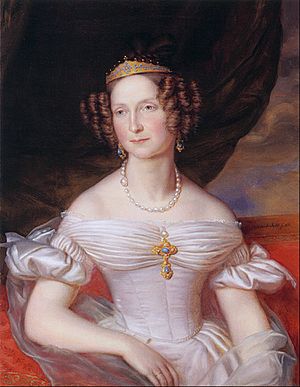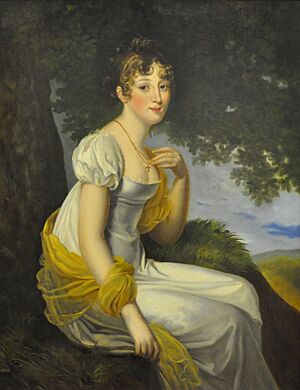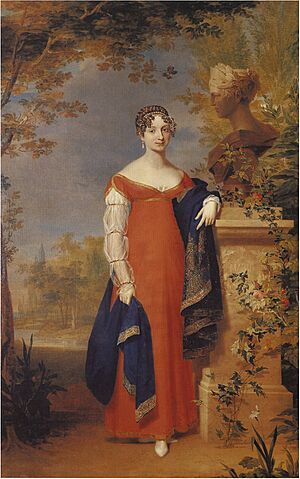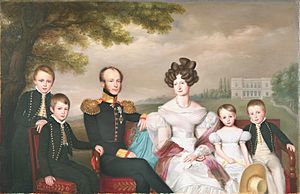Anna Pavlovna of Russia facts for kids
Quick facts for kids Anna Pavlovna of Russia |
|
|---|---|

Portrait by Jan Baptist van der Hulst, 1837
|
|
| Queen consort of the Netherlands Grand Duchess consort of Luxembourg Duchess consort of Limburg |
|
| Tenure | 7 October 1840 – 17 March 1849 |
| Born | 18 January 1795 Saint Petersburg, Russia |
| Died | 1 March 1865 (aged 70) The Hague, Netherlands |
| Burial | Nieuwe Kerk, Delft |
| Spouse | |
| Issue |
|
| House | Holstein-Gottorp-Romanov |
| Father | Paul I of Russia |
| Mother | Sophie Dorothea of Württemberg |
| Religion | Russian Orthodox |
Anna Pavlovna of Russia (born 18 January 1795 – died 1 March 1865) was a Russian Grand Duchess. She became the Queen of the Netherlands when she married William II of the Netherlands. Anna was very proud of her Russian heritage. She followed strict royal rules in the Netherlands. She always felt more like a Russian Grand Duchess than a Dutch Queen. Anna did not have political power. However, she was very active in charity work.
Contents
Early Life and Education
Anna Pavlovna was born in 1795 at Gatchina Palace in Russia. She was the eighth child of Paul I of Russia and Empress Maria Feodorovna. This made her an Imperial Highness, a Grand Duchess of Russia. Her father became emperor in 1796. He died in 1801 when Anna was six years old. Her brother Alexander then became the new emperor.
Anna grew up at Tsarskoye Selo, a summer palace. She lived there with her two younger brothers, Nicholas and Michael. She had a Swiss governess named Louise de Sybourg. Anna received a good education. She learned several languages, including Russian, German, and French. She also studied mathematics. Anna was skilled at handicrafts and painting.
She had a close relationship with her mother and her two younger brothers. They wrote letters to each other throughout her life. After her mother passed away, Anna relied on her brother Nicholas. He became emperor in 1825 and helped her often.
In 1809, Emperor Napoleon I of France wanted to marry Anna. He had first tried to marry her older sister, Ekaterina. Anna's mother delayed her answer. Napoleon eventually lost interest. He married Archduchess Marie Louise instead in 1810. Other important men also wanted to marry Anna. These included the Duc de Berry from France and the Duke of Clarence from Britain.
Marriage to William II
On 21 February 1816, Anna married the Prince of Orange. This wedding took place at the Winter Palace in St Petersburg. Her brother, Tsar Alexander I, had suggested the marriage. It was a symbol of the alliance formed after the Congress of Vienna. Before the wedding, William visited Russia. This allowed Anna to meet him and agree to the marriage. She was pleased with him, even though she felt her royal birth was higher than his.
They agreed that their children would be raised as Protestants. However, Anna remained a Russian Orthodox Christian. The famous poet Alexander Pushkin wrote a poem about their wedding. The couple stayed in Russia for a year after their marriage. Anna received a large dowry, which is money or property given by a bride's family. Her governess also moved with her to the Netherlands.
Life as Crown Princess
In the Netherlands, Anna and William lived in Kneuterdijk Palace and Soestdijk Palace. Anna was surprised by the differences between Russia and her new home. In the Netherlands, there was less difference between royalty and common people. This was very different from the strict class system in Russia. She found it hard to get used to this new way of life.
At that time, Belgium was part of the same kingdom. Anna and William preferred living in Brussels. They stayed there until the Belgian revolution in 1830. This revolution forced them to move back to the Netherlands. Anna liked Brussels more than the northern parts of the Netherlands. The French-speaking noble society in Brussels reminded her of court life in Saint Petersburg. She was also popular among the Belgian nobles.
Anna had several children during the 1820s. She had a good relationship with her children Henry and Sophia. Her favorite child was Alexander. However, she focused most of her attention on her oldest son, William. This was because he was the heir to the throne. Their relationship was often difficult. Anna tried to guide him, but she did not always succeed.
Her marriage to William was not always easy. In 1829, some of her jewelry was stolen. She suspected William because he had financial difficulties. His interest in other women also caused problems between them.
The Belgian revolution made Anna and William leave Brussels. They moved to the Netherlands. During the revolution, Anna acted as a peacemaker. She helped ease tensions between William and his father, the king. This was the only time Anna got involved in political matters. She publicly supported her husband. She went with him when his father sent him away to Willemsdorp.
After 1830, Anna stayed in the Netherlands as Crown Princess. She focused on her royal duties. She studied the Dutch language, history, and culture. She even learned to speak Dutch better than William. Anna believed it was her duty to help others. She founded over fifty orphanages. She also started charity groups and schools for poor women and girls. During the Belgian revolution, she opened a hospital for wounded soldiers. She visited them often.
Becoming Queen
On 7 October 1840, her father-in-law, William I of the Netherlands, stepped down from the throne. Anna then became the queen consort of the Netherlands. Her husband became King William II. Anna attended his inauguration ceremony in Amsterdam.
As queen, Anna was seen as dignified and proud. She was not very popular with the public. However, her goal was not to be popular. She wanted to be respected for doing her duty well. She valued formal court rules and royal appearances. The Dutch court became more grand and royal under her influence.
Anna Pavlovna was described as a tall and majestic woman. She was proud and always identified as an Imperial Grand Duchess. She never forgot her Russian heritage. She strictly followed royal etiquette and ceremonies. People recognized her as talented and intelligent. She quickly learned new languages. She also understood current political events well. She was strong-willed and could have a quick temper. Sometimes, she would stay in her rooms for days due to her "nerves." She was also very devoted to her mother and younger brothers.
Anna kept in touch with her family in Russia. She cherished memories of her home country. She remained a strong Russian patriot her whole life. It was often said that she was more a Russian Grand Duchess than a Dutch Queen. She had a private Russian Orthodox chapel in her home. She had her own priest and Russian choir boys. She kept her Orthodox religion and followed Russian customs. Sometimes, she even wore traditional Russian clothing.
Her letters showed that she was well-informed and had clear political opinions. However, she never got involved in politics publicly.
Queen Dowager
King William II became ill and passed away in March 1849. Anna was with him when he died. His sudden death was a shock to her. He also left behind many debts. Anna had to sell some of her own belongings. This helped her keep her favorite home, the Soestdijk Palace.
As a queen dowager (a queen whose husband has died), Anna left the royal palace. She retired from court life and lived privately. Her relationship with her son, King William III, was always difficult. She once said that he was happy to be a king of a constitutional country. She also did not get along with her daughter-in-law, Sophie. Sophie was her niece and the daughter of her sister Catherine, whom Anna liked the least. Anna was said to be jealous of Catherine's beauty.
Anna had better relationships with her two younger children. But they lived abroad. This made her last years lonely. She thought about returning to Russia after a disagreement with her son in 1855. However, she decided not to go. Anna died on 1 March 1865.
Children
Anna and William II of the Netherlands had five children:
- William III of the Netherlands (1817–1890). He married Sophie of Württemberg and later Emma of Waldeck and Pyrmont.
- William Alexander Frederick Constantine Nicholas Michael "Sasha" of the Netherlands (1818–1848).
- William Frederick Henry "the Navigator" of the Netherlands (1820–1879). He married Princess Amalia of Saxe-Weimar-Eisenach and later Marie of Prussia. He had no children.
- Prince William Alexander Ernst Frederick Casimir of the Netherlands (born 21 May 1822 – died 22 October 1822).
- Wilhelmina Marie Sophie Louise of the Netherlands (1824–1897). She married Karl Alexander, Grand Duke of Saxe-Weimar-Eisenach.
Legacy
The town of Anna Paulowna in the Dutch province of North Holland is named after her.
The group of trees called Paulownia was named in her honor. This was done by a German botanist named Philipp Franz von Siebold. The common name for Paulownia tomentosa is Royal Paulownia. It is also known as the Empress Tree or Princess Tree.
Images for kids
See also
 In Spanish: Ana Pávlovna Románova para niños
In Spanish: Ana Pávlovna Románova para niños










